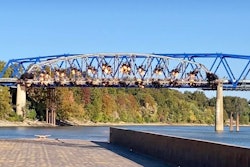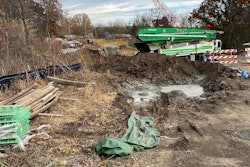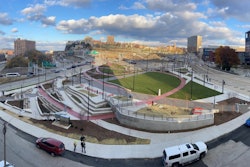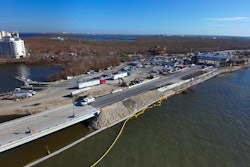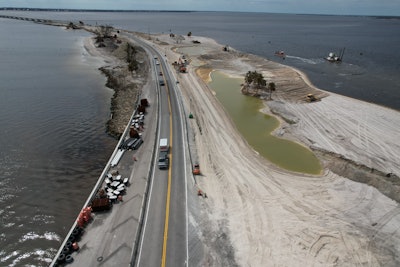
Superior Construction is no stranger to emergency road and bridge work.
Based in Florida, the company is often called out after hurricanes and other disasters to restore transportation infrastructure.
But the project the company faced September 30, two days after Hurricane Ian struck southwest Florida, was different for its severity. The Sanibel Causeway, the only link between Sanibel Island and the mainland, had washed out in multiple areas along the 3-mile thoroughfare.
{Related Content: Before and after photos of the Sanibel Causeway work}
“It was definitely shocking,” says Ryan Hamrick, division manager at Superior. “You see the pictures from the news coverage and aerial footage of the damage, but photos and videos really don't do it justice. When you're able to put your feet on the ground and see firsthand, it gives you a new respect for the power of these storms. And in this situation, storm surge, to see what it can do to the things that we build every day. It's pretty eye-opening.”
Though the task looked daunting when representatives of Superior, its joint-venture partner de Moya Group and the Florida Department of Transportation surveyed the damage that day in September, a singleness of purpose took hold:
Land access to the devastated communities must be restored as quickly as possible.
“Any resource that was needed, they were all on board with, all the way up to the governor's office,” Hamrick says. “They were pulling every string that they could to make things go faster and smoother.”
After an assessment, FDOT projected the work to rebuild temporary access on the causeway to take until the end of October. Superior and de Moya were able to complete it by October 19, more than a week sooner than expected. (Aerial footage of the repairs is available at the end of this story.)
Attacking the damage
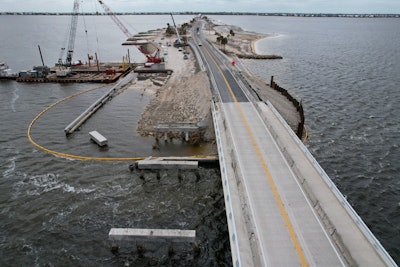 Equipment was brought in by barge, boat and land for the rapid response to repair the Sanibel Causeway.Superior Construction
Equipment was brought in by barge, boat and land for the rapid response to repair the Sanibel Causeway.Superior Construction
Superior and de Moya used their connections to get equipment and materials, in most cases delivered within 24 hours.
But there were some obstacles to overcome.
“Getting crews and equipment to the actual damaged areas was one of the big challenges,” Hamrick says. “But really on this particular kind of job, everything's a challenge.”
Road travel to the area involved traversing debris, downed power lines and no traffic signals. Then there’s the matter of where to house the crews for several weeks on a 24/7 operation. Also, how will you feed them? And how will you get fuel for the equipment?
They were able to connect with first responders who had set up mobile accommodations at a nearby local airport for housing most of the workers. For others they were able to find some condos and hotel rooms that were still habitable.
“There were tons of crews out there,” Hamrick says. “We had multiple boats; we had multiple barges with equipment mounted on top of the barges.”
Tides and the shallow water also proved challenging.
“Because of all the storm surge that went through, it moved a bunch of material around. So where water didn't use to be shallow, it was now shallow. So you had to be very careful and cautious about where you could and could not go.”
Working until the last minute
 The Sanibel Causeway was reopened October 19. Now attention turns to permanent repairs.Superior Construction
The Sanibel Causeway was reopened October 19. Now attention turns to permanent repairs.Superior Construction
Crews worked around the clock simultaneously at each of the breached areas.
“We were getting good chunks of the job completed each and every day,” Hamrick says. “It was always a push-to-the-end mentality. The level of work didn't stop until the morning of, when traffic was put back on onto the causeway.” That day came October 19 when the causeway was reopened allowing emergency responders, disaster aid workers and residents to reach the no-longer-isolated communities.
“The joy level was pretty high; the exhaustion level was equally as high,” says Hamrick of the crews when the job was done. “Everyone needed to take a little break and take a day or two away from it to exhale. But the sense of accomplishment, that sense of teamwork, everyone working together, it was good to see, good to be a part of.”
Superior and de Moya will also continue their joint venture as the contractor for permanent restoration of the causeway. Designers are developing a solution that will be submitted to FDOT for approval. One of the goals is to keep the traffic that recently returned to the island flowing. The work will likely be done in phases to reduce disruption.
Hamrick says a design will probably be submitted to FDOT by mid-November. “We're out there every day, even now today as we speak, assessing some different solutions with our designers, going through some things with DOT, making sure we're continuing to be on the same page and collaborate toward the common solution of how we want this to look at the end of the day.”
A time frame on how long the work will take has not been set, but FDOT has indicated it would like it completed within a year.
“So that clock is ticking,” Hamrick says. “And I know we'll attack that with some schedule urgency as well, because those people are dealing with enough. They don't need to be dealing with a lot of construction going on.”
To see the results of the repair work, check out Superior Construction's aerial footage below:





